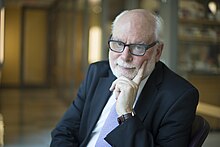
Back فريزر ستودارت Arabic জেমছ ফ্ৰাছাৰ ষ্টদদাৰ্ট Assamese فراسر استودارت AZB Фрэйзер Стодарт Byelorussian Фрейзър Стодарт Bulgarian ফ্রেজার স্টডার্ট Bengali/Bangla Fraser Stoddart Catalan Fraser Stoddart Czech Fraser Stoddart Danish Fraser Stoddart German
This article contains content that is written like an advertisement. (February 2024) |




Sir James Fraser Stoddart FRS FRSE HonFRSC[1] (born 24 May 1942[5]) is a British-American chemist who is Chair Professor in Chemistry at the University of Hong Kong.[8] He has also been Board of Trustees Professor of Chemistry and head of the Stoddart Mechanostereochemistry Group in the Department of Chemistry at Northwestern University in the United States.[9] He works in the area of supramolecular chemistry and nanotechnology. Stoddart has developed highly efficient syntheses of mechanically-interlocked molecular architectures such as molecular Borromean rings, catenanes and rotaxanes utilising molecular recognition and molecular self-assembly processes. He has demonstrated that these topologies can be employed as molecular switches.[10] His group has even applied these structures in the fabrication of nanoelectronic devices and nanoelectromechanical systems (NEMS).[11] His efforts have been recognized by numerous awards, including the 2007 King Faisal International Prize in Science.[12][13][14] He shared the Nobel Prize in Chemistry together with Ben Feringa and Jean-Pierre Sauvage in 2016 for the design and synthesis of molecular machines.[2][15][16][17][18]
- ^ a b Anon (1994). "Sir James Stoddart FRS". royalsociety.org. London: Royal Society. Archived from the original on 15 August 2016. One or more of the preceding sentences incorporates text from the royalsociety.org website where:
All text published under the heading 'Biography' on Fellow profile pages is available under Creative Commons Attribution 4.0 International License." --"Royal Society Terms, conditions and policies". Archived from the original on 25 September 2015. Retrieved 9 March 2016.
{{cite web}}: CS1 maint: bot: original URL status unknown (link) - ^ a b Staff (5 October 2016). "The Nobel Prize in Chemistry 2016". Nobel Foundation. Retrieved 5 October 2016.
- ^ a b "James Fraser Stoddart: Curriculum Vitae, Full Version" (PDF). stoddart.northwestern.edu. Archived from the original (PDF) on 5 October 2016.
- ^ "2009 winner of the RSC Merck Award". Royal Society of Chemistry. Retrieved 6 October 2016.
- ^ a b c "STODDART, Sir (James) Fraser". Who's Who. Vol. 1997 (online Oxford University Press ed.). Oxford: A & C Black. (Subscription or UK public library membership required.)
- ^ Cite error: The named reference
Awardwas invoked but never defined (see the help page). - ^ "Norma Stoddart (Obituary)". The Scotsman. 16 February 2004. Retrieved 27 May 2016.
- ^ https://www.hku.hk/press/news_detail_26533.html
- ^ "Nanotechnology Star Fraser Stoddart to Join Northwestern". NewsCenter. Northwestern University. 16 August 2007. Archived from the original on 4 July 2019. Retrieved 17 August 2007.
- ^ A. Coskun, M. Banaszak, R. D. Astumian, J. F. Stoddart, B. A. Grzybowski, Chem. Soc. Rev., 2012, 41, 19–30
- ^ A. Coskun, J. M. Spruell, G. Barin, W. R. Dichtel, A. H. Flood, Y. Y. Botros, J. F. Stoddart. Chem. Soc. Rev., 2012, 41 (14), 4827–59.
- ^ The Scientists' Channel. "Sir James Fraser Stoddart". www.thescientistschannel.com. Retrieved 11 February 2021.
- ^ "Stoddart Wins King Faisal International Prize". Chemical & Engineering News. 85 (12): 71. 19 March 2007. Retrieved 26 May 2016.
- ^ "Fraser Stoddart is awarded the 2007 King Faisal International Prize for Science". California NanoSystems Institute. 17 January 2007. Archived from the original on 10 February 2007.
- ^ Chang, Kenneth; Chan, Sewell (5 October 2016). "3 Makers of 'World's Smallest Machines' Awarded Nobel Prize in Chemistry". The New York Times. Retrieved 5 October 2016.
- ^ Davis, Nicola; Sample, Ian (5 October 2016). "live". the Guardian. Retrieved 5 October 2016.
- ^ "The Nobel Prize in Chemistry 2016". NobelPrize.org.
- ^ Van Noorden, Richard; Castelvecchi, Davide (2016). "World's tiniest machines win chemistry Nobel". Nature. 538 (7624): 152–153. Bibcode:2016Natur.538..152V. doi:10.1038/nature.2016.20734. PMID 27734892.
© MMXXIII Rich X Search. We shall prevail. All rights reserved. Rich X Search
